Fengxiang New Year Picture
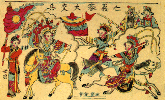
It is a type of folk woodblock picture popular in the southwest of China and produced in Fengxiang County, Shaanxi Province. Shili Village is famous for its large variety of woodblocks. At the beginning of the Qing Dynasty, some workshops engraved, printed, and sold New Year pictures. It is coloured in orange, green, and red.
Foshan New Year Picture

It is popular in the south of China and produced in Foshan, Guangdong Province. It originated in the Yongle Period of the Ming Dynasty, flourished in the Qianlong Period and the Jiaqing Period of the Qing Dynasty. The picture shops were situated in the Water Lane and the Fulu Lane. Foshan New Year picture consists of three types: original picture, woodblock picture, and woodblock realistic picture. Its themes run a range of gate god, festival picture, etc.
Wuxi Paper Horse

It is popular in Wuxi, Jiangsu Province, and used for folk sacrifice. One of the types is printed in black, and others are printed on coloured paper with ink plate. The latter is distinguished for its printing process which consists of printing, painting and printing again. It is like the theatrical roles' masks.
Ci County Paper Horse

More than 70 original editions of this paper horse were found in 1987 with pictures on both plates. The negative side is in the form of a square on which many spirits were printed.
Yunnan Paper Horse
It is popular in the middle, northwest and south of Yunnan Province. As estimated, its varieties are numbered at 3600.
Anhui Woodblock Picture
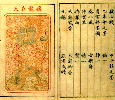
It belongs to the school of Anhui woodblock. Huizhou (now it is Shexian) is the center of publishing enterprise in the Ming and Qing Dynasties. Both the woodblock picture printed in Huizhou Prefecture and the woodblock picture printed in other areas but by Huizhou natives are called Huizhou woodblock picture. Huizhou woodblock picture flourished in the middle of the Ming Dynasty, among which the picture printed by the Huan family was the most famous. Others were picture printers called Bao, Wang and Tang. Later on elite and men of letters got involved in its development and thus many masterpieces were generated.
Jinling Blockprinting Picture
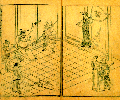
It belongs to the school of block print picture. It is in vogue in the area of Jinling, now Nanjing, Jiangsu Province. It was in boom in Ming Dynasty. Along Sanshan Street there were many workshops blockprinting and selling books. Among these workshops there were Fuchuntang, Shidetang, Jizhizhai, Weilingge, Guangqingtang, Huancuitang, Shizhuzhai, Jieziyuan, etc. Their representative works were The Collection of Pictures, Jinling Sanskrit Temples and the Pictorial Biography of Jieziyuan Pictures, etc.
Wulin Blockprinting Picture
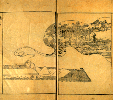
It belongs to the school of blockprinting picture. It is printed in Hangzhou, Zhejiang Province. Wuling used to be the center of blockprinting since the Song and Yuan Dynasties. In the Southern Song Dynasty the printing houses were situated in Wazi Street. In this period the representative works were The Pictorial Eulogy of the Zenist, The Book of Law and Lotus, The Plum Biography of Happy Spirits.
Jian'an Blockprinting Picture

It belongs to the school of blockprinting picture. It was printed in Jian'an , Fujian Province. Jian'an was one of the book printing centers in the Song, Yuan and Ming Dynasties. Its representative works were The Women of Virtues printed in the Song Dynasty and The Five Talkstories printed in the Yuan Dynasty. Their pattern is such as the picture on the upper part and the characters on the lower part.
Blockprinted Paper Card
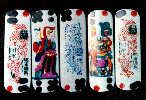
It is a type of gambling device. It took the form of a rectangular, was blockprinted, and figures and decorating patterns were added.
Blockprinting Promotion Picture
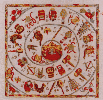
It is an ancient gambling device or toy, and was blockprinted. One can throw a die onto the picture and get a promotion by the colour the die drops on.
Farmers' Picture
It is one of the popular pictures. It is printed and appreciated by farmers. Its forms run the range of self-printed paper horse, gate gods, the portrait of spirits, etc. Nowadays some farmers paint pictures describing rustic life on paper.
Gaomi Powder-Sprayed Picture

It is one type of folk New Year pictures in Gaomi County, Shandong Province. It originated in the Ming Dynasty. To brighten the picture and make it more eye-catching, a kind of brightening oil is smeared on it. This manually made picture selects women and children as its themes.
Phoenix Picture

It is a type of picture enjoying popularity in Fengyang County, Anhui Province. It chooses phoenix as its theme, indicative of propitiousness and happiness. Generally it serves as picture hung on the wall facing the door on the Spring Festival.
West Lake Scene
It is also called "Western mirror" and in the north it is called "pulling foreign celluloid". It is a type of entertainment emerging in the contemporary time. The viewer looks at the picture through a mirror box. The picture can be pulled back and forth. The characters on the picture can also move. The operator sings while pulling.
The Stove-End Picture
It is a type of decorative pattern or a picture of theatrical tale which is painted on the ends of a stove. It is painted in a single colour or several colours. Most of its makers are architectural craftsmen in the countryside.
Farmer's Picture Of Pi County
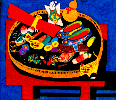
Pi County in Jiangsu Province is a place where farmer's picture is produced. In the fifties, farmer painters formed the main creating body of pictures. In that period, almost all members in each household liked to draw pictures on wall. It enjoyed a nationwide fame and was well received from all walks of life. Their works reflected rural life, farmer's thoughts and feelings, and their best wishes for the future. They were constituted deftly and boldly expressive beyond limits.Their themes include "Raising Silkworm", "Making Beancurd", "Flaming Mountain", "Waterfall Cave", etc.
Jinshan Farmer Picture
In 1970s, a modern farmer painting campaign was launched in Jinshan County of Shanghai. The painters amounted to more than 300, from farmers aged 70 to youngsters aged 10 among which the female farmers were the majority. They were inspired by the folk embroidery and paper-cutting. Cultivated in this aroma, they secured an expression of their own life with profound imagination.










